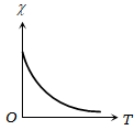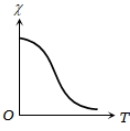A dip needle vibrates in the vertical plane perpendicular to the magnetic meridian. The time period of vibration is found to be 2 seconds. The same needle is then allowed to vibrate in the horizontal plane and the time period is again found to be 2 seconds. Then the angle of dip is
1. 0o 2. 30o
3. 45o 4. 90o
A bar magnet has coercivity . It is desired to demagnetize it by inserting it inside a solenoid 12 cm long and having 60 turns. The current that should be sent through the solenoid is
1. 2 A 2. 4 A
3. 6 A 4. 8 A
For substances hysteresis (B - H) curves are given as shown in figure. For making temporary magnet which of the following is best?
| 1. |  |
2. |  |
| 3. |  |
4. |  |
The variation of magnetic susceptibility with temperature for a diamagnetic substance is best represented by
1. 
2. 
3. 
4. 
The variation of magnetic susceptibility with absolute temperature T for a ferromagnetic material is
1. 
3. 
The relative permeability of a ferromagnetic substance varies with temperature (T) according to the curve:
1. A
2. B
3. C
4. D
Some equipotential surfaces of the magnetic scalar potential are shown in the figure. The magnetic field at a point in the region is: (X-axis read in cm)
1.
2.
3.
4. None of these
The figure illustrates how B, the flux density, inside a sample of unmagnetized ferromagnetic material varies with B0, the magnetic flux density, in which the sample is kept. For the sample to be suitable for making a permanent magnet:
1. OQ should be large and OR should be small
2. OQ and OR should both be large
3. OQ should be small and OR should be large
4. OQ and OR should both be small
The variation of the intensity of magnetisation (I) with respect to the magnetising field (H) in a diamagnetic substance is described by the graph
1. OD 2. OC
3. OB 4. OA
A current-carrying loop is placed in a uniform magnetic field in four different orientations, I, II, III & IV. The decreasing order of potential energy is:

| 1. | I > III > II > IV | 2. | I > II >III > IV |
| 3. | I > IV > II > III | 4. | III > IV > I > II |






